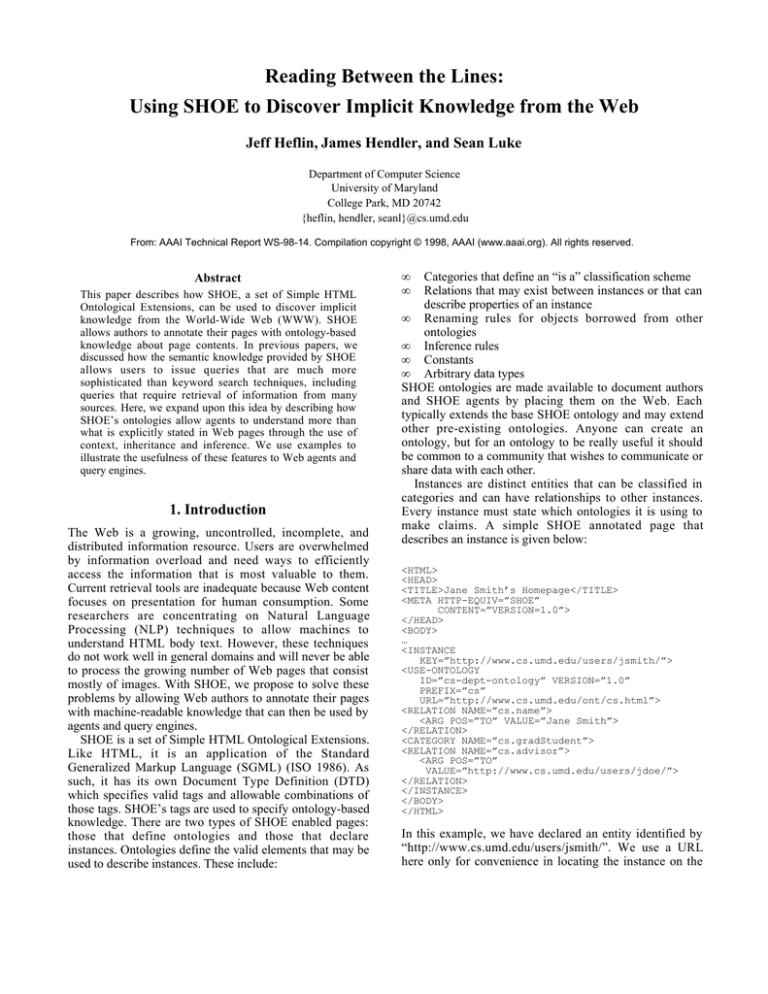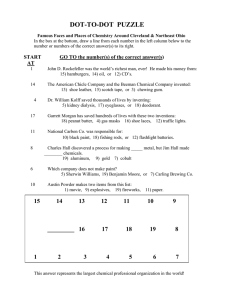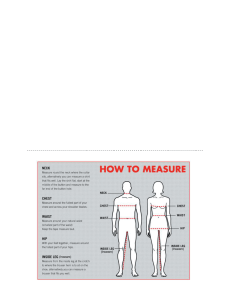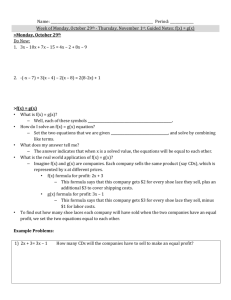
Reading Between the Lines:
Using SHOE to Discover Implicit Knowledge from the Web
Jeff Heflin, James Hendler, and Sean Luke
Department of Computer Science
University of Maryland
College Park, MD 20742
{heflin, hendler, seanl}@cs.umd.edu
From: AAAI Technical Report WS-98-14. Compilation copyright © 1998, AAAI (www.aaai.org). All rights reserved.
Abstract
This paper describes how SHOE, a set of Simple HTML
Ontological Extensions, can be used to discover implicit
knowledge from the World-Wide Web (WWW). SHOE
allows authors to annotate their pages with ontology-based
knowledge about page contents. In previous papers, we
discussed how the semantic knowledge provided by SHOE
allows users to issue queries that are much more
sophisticated than keyword search techniques, including
queries that require retrieval of information from many
sources. Here, we expand upon this idea by describing how
SHOE’s ontologies allow agents to understand more than
what is explicitly stated in Web pages through the use of
context, inheritance and inference. We use examples to
illustrate the usefulness of these features to Web agents and
query engines.
1. Introduction
The Web is a growing, uncontrolled, incomplete, and
distributed information resource. Users are overwhelmed
by information overload and need ways to efficiently
access the information that is most valuable to them.
Current retrieval tools are inadequate because Web content
focuses on presentation for human consumption. Some
researchers are concentrating on Natural Language
Processing (NLP) techniques to allow machines to
understand HTML body text. However, these techniques
do not work well in general domains and will never be able
to process the growing number of Web pages that consist
mostly of images. With SHOE, we propose to solve these
problems by allowing Web authors to annotate their pages
with machine-readable knowledge that can then be used by
agents and query engines.
SHOE is a set of Simple HTML Ontological Extensions.
Like HTML, it is an application of the Standard
Generalized Markup Language (SGML) (ISO 1986). As
such, it has its own Document Type Definition (DTD)
which specifies valid tags and allowable combinations of
those tags. SHOE’s tags are used to specify ontology-based
knowledge. There are two types of SHOE enabled pages:
those that define ontologies and those that declare
instances. Ontologies define the valid elements that may be
used to describe instances. These include:
•
•
Categories that define an “is a” classification scheme
Relations that may exist between instances or that can
describe properties of an instance
• Renaming rules for objects borrowed from other
ontologies
• Inference rules
• Constants
• Arbitrary data types
SHOE ontologies are made available to document authors
and SHOE agents by placing them on the Web. Each
typically extends the base SHOE ontology and may extend
other pre-existing ontologies. Anyone can create an
ontology, but for an ontology to be really useful it should
be common to a community that wishes to communicate or
share data with each other.
Instances are distinct entities that can be classified in
categories and can have relationships to other instances.
Every instance must state which ontologies it is using to
make claims. A simple SHOE annotated page that
describes an instance is given below:
<HTML>
<HEAD>
<TITLE>Jane Smith’s Homepage</TITLE>
<META HTTP-EQUIV=”SHOE”
CONTENT=”VERSION=1.0”>
</HEAD>
<BODY>
…
<INSTANCE
KEY=”http://www.cs.umd.edu/users/jsmith/”>
<USE-ONTOLOGY
ID=”cs-dept-ontology” VERSION=”1.0”
PREFIX=”cs”
URL=”http://www.cs.umd.edu/ont/cs.html”>
<RELATION NAME=”cs.name”>
<ARG POS=”TO” VALUE=”Jane Smith”>
</RELATION>
<CATEGORY NAME=”cs.gradStudent”>
<RELATION NAME=”cs.advisor”>
<ARG POS=”TO”
VALUE=”http://www.cs.umd.edu/users/jdoe/”>
</RELATION>
</INSTANCE>
</BODY>
</HTML>
In this example, we have declared an entity identified by
“http://www.cs.umd.edu/users/jsmith/”. We use a URL
here only for convenience in locating the instance on the
Figure 1. A Parka Query on the Knowledge Base Created by Exposé
Web; SHOE instances are not necessarily tied to specific
physical HTML documents. This instance uses the “csdept-ontology” to declare categories and relationships. The
name of the instance is “Jane Smith”. Jane Smith is a
graduate student and has an advisor whose instance is
identified by “http://www.cs.umd.edu/users/jdoe/”. Note
that every category and relationship has a prefix that
indicates it comes from this ontology. If we used more
ontologies, then there would be additional categories and
relationships with different prefixes. For a detailed
description of SHOE’s syntax see the SHOE Specification
(Luke and Heflin 1997).
We have designed applications to demonstrate SHOE’s
promise. For example, we have developed Exposé, a webcrawler that looks for SHOE pages and loads them into a
Parka knowledge base (Evett, Andersen, and Hendler
1993; Stoffel, Taylor, and Hendler 1997). The content can
then be examined using Parka’s query facilities. A Parka
query concerning the authors of SHOE publications is
shown in Figure 1. The Parka query tool tailored for use
with SHOE includes a feature to view Web pages relevant
to the query results with a Web browser. We have also
built the Knowledge Annotator, a graphical application that
makes it easy to annotate Web pages with SHOE. This tool
prompts the user for information about instances, relations
and categories, and automatically adds the appropriate
SHOE tags to an existing HTML document. See Figure 2
for a screenshot from this tool. To support these and future
applications, we have implemented C and Java libraries for
parsing SHOE documents and manipulating the
information contained within.
2. Related Work
HTML 2.0 (Berners-Lee and Connolly 1995) includes
several weak mechanisms for semantic markup (the REL,
REV and CLASS subtags and the META tag). HTML 3.0
(Ragget 1995) advances these mechanisms somewhat.
Unfortunately, the semantic markup elements of HTML
have so far been used primarily for document metainformation (such as declared keywords) or for hypertextoriented relationships (like “abstract” or “table of
contents”). Furthermore, relationships can only be
established along hypertext links (using <LINK> or <A>).
To address the limitations of HTML, Dobson and Burrill
(1995) have attempted to reconcile it with the EntityRelationship (ER) database model. This is done by adding
to HTML a simple set of tags that define “entities” within
documents, labeling sections of the body text as
“attributes” of these entities, and defining relationships
from an entity to outside entities. However, this scheme
does not provide a means for uncovering knowledge other
than that which is explicitly stated by the author of the
document.
Figure 2. The Knowledge Annotator
Many research projects aim to make the Web more
productive by adding database functionality. Some projects
focus on creating query languages for the Web (Arocena,
Mendelzon, and Mihaila 1997; Konopnicki and Shmueli
1995). However these approaches are limited to queries
concerning the HTML structure of the document and the
hypertext links. They also rely on index servers such as
Alta Vista or Lycos to search for words or phrases, and
thus suffer from the limitations of keyword search. Yet
another approach involves mediators (or wrappers),
custom software that serves as an interface between
middleware and a data source (Wiederhold 1992;
Papakonstantinou et al. 1995; Roth and Schwarz 1997).
When applied to the Web, wrappers allow users to query a
page’s contents as if it was a database. However, the
heterogeneity of the Web requires that a multitude of
custom wrappers must be developed, and it is possible that
important relationships cannot be extracted from the text
based solely on the structure of the document. Semiautomatic generation of wrappers (Ashish and Knoblock
1997) is a promising approach to overcoming the first
problem, but is limited to data that has a recognizable
structure.
The projects most similar to SHOE are creating
languages to help machines process and understand Web
documents. The Resource Description Framework (RDF)
(Lassila and Swick 1998) is a work in progress by the
World-Wide Web Consortium (W3C). RDF is similar in
concept to SHOE, but has few inferential capabilities and is
limited to binary relations. The Web Analysis and
Visualization Environment (WAVE) project (Kent and
Neuss 1995) has designed the Ontology Markup Language
(OML) and Conceptual Knowledge Markup Language
(CKML), both of which are in part based on SHOE.
The Extensible Markup Language (XML) (Bray, Paoli,
and Sperberg-McQueen 1998) has been proposed as a
restricted form of SGML intended to ease the processing of
documents on the Web. XML allows web authors to create
customized sets of tags for their documents. Style sheets
can be designed to display each set in a standard manner.
However, the flexibility of XML will make it difficult for
general intelligent agents to work with these documents
since the tags developed by different authors can have the
same semantics. Additionally, agents can only make use of
the structure and knowledge provided explicitly on the
page. SHOE was designed to use the same subset of SGML
as XML, and thus can be thought of as an XML application
that provides a standard way to encode useful knowledge
in Web documents.
3. Discovering Implicit Knowledge
When people read documents, they draw on their
knowledge of the domain and general language to interpret
individual statements. Queries that can be answered easily
by a human reader are difficult for most query software
because the software does not have the benefit of this
implicit knowledge. However, when a SHOE instance
makes specific claims based on the semantics in a
particular ontology, a Web agent can then draw on that
ontology to infer additional knowledge not directly stated.
All of SHOE’s implicit knowledge arises from its use of
ontologies. Three types of implicit knowledge are
provided.
First, the ontology provides context. For example, there
might be a relation called “takes” in both the “universityontology” and the “medicine-ontology”. In the former,
“takes” is meant as in to “take a class”. In the later, it is
meant as in to “take medicine”. If an NLP system saw the
word “takes”, it would have to disambiguate between the
many meanings of the word, relying on sentence structure
and related words to accomplish its task. A SHOE agent,
however, will not be confused because it knows what
ontology is being used, and therefore it knows the context.
Furthermore, SHOE requires that every category and
relation have a prefix chain that identifies its original
ontology. Thus, even if a page uses ontologies that have a
namespace conflict, it is always clear which relationship is
intended.
Second, an ontology provides a taxonomy, or
categorization framework. For example, the “cs-deptontology” might state that a “ResearchAssistant” is a
“GraduateStudent” which is a “Student” which is a
“Person”. A SHOE ontology would encode this
information as follows:
<DEF-CATEGORY NAME=”Person”>
<DEF-CATEGORY NAME=”Student” ISA=”Person”>
<DEF-CATEGORY NAME=”GraduateStudent”
ISA=”Student”>
<DEF-CATEGORY NAME=”ResearchAssistant”
ISA=”GraduateStudent”>
In the real world, and similarly on the Web, an object could
belong to many categories. Therefore, SHOE allows
multiple inheritance.
The categorization hierarchy can be used to generalize or
specialize a query. For example, software implementing a
query to find students can also return pages that had been
declared “ResearchAssistants” or “GraduateStudents”.
Thus, users can specify queries at the hierarchical level that
meets their needs; the query engine will return the right
answer.
Third, a SHOE ontology allows inferences to be defined.
This gives agents the tools to perform logical reasoning on
Web pages. A SHOE inference is similar to a Horn clause
in that it consists of a body (INF-IF) of one or more
subclauses describing claims that entities might make, and
a head (INF-THEN) consisting of one or more subclauses
describing a claim that may be inferred if all claims in the
body are made. Like Horn clauses, SHOE does not allow
negations in its implications1. This restriction reduces
computational complexity because polynomial-time
inference on a set of Horn clauses can be accomplished
1 In conjunctive normal form a Horn clause can have no
more than one positive literal.
using Modus Ponens. Furthermore, if SHOE allowed
negations it would be possible for the conclusion of an
inference to contradict a known fact. This is obviously
problematic because reasoning with an inconsistent set of
facts can lead to any conclusion desired.
The three types of SHOE subclauses are category,
relation and comparison. The arguments of any subclause
may be a constant or a variable. Variables are indicated by
the keyword VAR. Constants must be matched exactly;
variables of the same name must bind to the same value.
The following example illustrates the construction of an
inference that uses all three types of subclauses.
<DEF-INFERENCE>
<INF-IF>
<CATEGORY NAME=”Car” VAR FOR=”X”>
<RELATION NAME=”age”>
<ARG POS=1 VAR VALUE=”X”>
<ARG POS=2 VAR VALUE=”A”>
</RELATION>
<COMPARISON OP=”greaterThan”>
<ARG POS=1 VAR VALUE=”A”>
<ARG POS=2 VALUE=”25”>
</COMPARISON>
</INF-IF>
<INF-THEN>
<CATEGORY NAME=”Antique” VAR FOR=”X”>
</INF-THEN>
</DEF-INFERENCE>
Any SHOE inference can be expressed in first-order
logic. Relation clauses simply become predicate
expressions. Category clauses require unary predicates that
establish membership. Comparison clauses require a binary
predicate for each of the types of SHOE comparisons.
Likewise, any sentence in first-order logic that can be
expressed as a Horn clause can be expressed as a SHOE
inference. The first-order logic equivalent of the above
inference is:
∀x,a Car(x) ∧ Age(x,a) ∧ greaterThan(a,25) ⇒
Antique(x)
The reader may have observed that SHOE notation is more
cumbersome than first-order logic.2 However, since SHOE
is an SGML application, it has the advantage that it can be
parsed quickly by a simple SGML parser. Additionally,
XML tools not specifically designed for SHOE can process
the tags to a limited extent. Still, since first-order logic is a
more compact notation, all of the subsequent examples in
this paper will be expressed using first-order logic.
Obviously, there are many types of rules that can be
expressed using SHOE’s inference mechanism. Below are
some example inferences from a hypothetical university
ontology:
•
∀x Professor(x) ⇒ hasDegree(x, “PhD”)
2 We are currently extending the Knowledge Annotator so
that users can define inferences with a minimum of effort.
•
•
•
∀x,y Colleague(x,y) ⇒ Colleague(y,x)
∀x,y Teaches(x,y) ⇒ StudentOf(y,x)
∀x,y,z WorksFor(x,y) ∧ SubOrg(y,z) ⇒
WorksFor(x,z)
The first example shows that having a Ph.D. is a necessary
condition of being a professor. This allows queries
searching for people with doctoral degrees to also return
pages that only happen to mention that the instance is a
professor. The second example shows that the
Colleague relation is symmetric. This allows agents to
ignore the ordering of the arguments for that relation. The
third example establishes that Teaches and StudentOf
are inverse relationships. With this inference, the point of
view of the Web author does not have to match that of the
agent or query. Finally, the last sentence expresses the
transitivity of the W o r k s F o r relation through the
SubOrg relation. In short, it says that if someone works
for an organization and that organization is part of another
organization, then the person also works for the second
organization. This allows someone who works indirectly
for an organization to be found by traversing the
organization hierarchy, which may be expressed on other
Web pages. As can be seen here, useful queries can be
made against the predicates in the head clauses even if no
page has made any declarations using those predicates.
Similar types of inferences can be constructed for any
domain.
To fully understand the power that SHOE provides, we
will examine a more complex example than the ones
above. Assume that you are looking for a list of experts on
“Knowledge Representation”. A simple keyword search
will get you a lot of hits, many of them not what you were
looking for. For example, there will be a lot of pages on
conferences or indices concerning knowledge
representation. Additionally, if someone mentions that they
read a book or took a class on the subject, then they are as
likely to be returned by a simple search engine as someone
who taught a class or wrote a book on the subject. You
could try adding the words “teach” or “wrote” to your
query and this will improve your results, but you will still
get false hits that include people who taught classes or
wrote books on other topics. SHOE has none of these
problems. Let’s assume that the “computer-science”
ontology has defined an expert on a subject as someone
who has taught a class in or authored a publication on that
subject. The following rules would express this:
•
•
∀p,c,x Teach(p,c) ∧ Subject(c,x) ⇒
Expert(p,x)
∀p,b,x AuthorOf(p,b) ∧ Subject(b,x) ⇒
Expert(p,x)
A SHOE query engine could use these rules to find people
that match this definition of expert. Note that when we
query SHOE documents, we must specify the context of
the query by specifying the ontologies that we are using.
Thus, other ontologies may define expert differently but
the query will use the definition from the current context.
This particular query may also use SHOE’s categorization
feature. For example, if the ontology defines “Semantic
Network” as a sub-category of “Knowledge
Representation”, then the SHOE query engine will also be
able to return people who are experts on a specific type of
knowledge representation.
One of the most interesting potential Web applications
for inference is in determining the validity of information.
Since the Web is uncontrolled, information that is either
subjective or factually incorrect is often published.
Intelligent agents must not believe everything they read.
Instead, they must treat knowledge found on the Web as a
claim made by some party. A truly intelligent agent should
be able to rank knowledge not only by how well it matches
the criteria to perform an action, but also by how accurate
the data is believed to be. This could be accomplished with
SHOE by using inference and two special relations. The
relation Claims(x, p, y, z) states that x claims y is
related to z through predicate p. The relation
Believe(p, x, y, b) states that we believe x is
related to y through predicate p if b is true (where b is a
boolean value). For example, we would be more willing to
believe that someone is married to Madonna if she makes
the same claim on her page. The inference rule might look
like this:
∀x,y Claims(x, “MarriedTo”, x, y) ∧
Claims(y, “MarriedTo”, x, y) ⇒
Believe(“MarriedTo”, x, y, true)
Of course, this inference rule would work for any claims of
marriage, not just marriage to Madonna. Alternatively, we
might consider certain sources so unreliable that we never
believe anything they say. For example:
∀p,x,y Claim(“National Inquirer”, p, x, y)
Believe(p, x, y, false)
⇒
It is important to note here that the above inference does
not mean that anything claimed by the National Inquirer is
necessarily false, it simply means that agents should ignore
any claims by this party. It is likely that different users are
willing to believe different things. Coupled with inference,
the two relations above allow complex belief systems to be
constructed and tailored to a specific user or user group.
4. Future Work
Although we feel our current specification provides much
of the expressiveness needed for more advanced WWW
agents, it still lacks important features found in
sophisticated knowledge-representation systems. We are
adding such features conservatively, seeking a compromise
that provides much of the power of knowledge
representation tools while keeping the system simple,
efficient and understandable to the lay community. We also
plan to keep SHOE in step with all applicable standards.
We are watching developments in XML and plan to keep
SHOE compatible with it.
The main thrust of current research is building tools that
demonstrate and test the capabilities of the language. In
addition to the tools that have already been built, we are
designing a number of agents, including:
• personal assistants that continuously scout the Web for
information of interest to their masters
• on-line guides that help users browse by reading ahead
of the user and suggesting the best links to follow
• on-line search engines that search the web in direct
response to queries, intelligently using SHOE both to
determine the validity and usefulness of information,
as well as where to search next
• dynamic visualization tools that graphically display
important relationships between objects and allow
users to browse the Web at varying levels of
abstraction
To implement these systems we must re-examine literature
on databases as well as artificial intelligence, and apply the
concepts to the unique situations of knowledge
representation on the Web. Of particular interest are
deductive databases and query planning in a distributed
environment.
We are currently working with the Joint Institute for
Food Safety and Applied Nutrition (JIFSAN) to fully
annotate a comprehensive web site on Transmissible
Spongiform Encephalopathy (TSE) Risk. JIFSAN, a
cooperative agreement between the Food and Drug
Administration (FDA) and the University of Maryland, is
part of the President’s Food Safety Initiative. This project
allows us to apply SHOE to a large, real-world domain.
The developmental ontology already includes elements
from biology, medicine, and manufacturing. This work will
help us to determine if SHOE has the correct level of
expressiveness for Web documents.
Finally, we are investigating the possibilities of claim
validation. We believe this is an important issue to the
success of intelligent agents acting on the Web. However,
the idea suggested in this paper produces its own set of
problems. How do we determine what are the “ground
terms” in our beliefs? Some things must be believed
without a corresponding Believe() relation. Otherwise, we
would never believe anything. How does one subscribe to a
belief system and what complications will arise from
subscribing to more than one belief system? Would
establishing a degree of belief be significantly more useful
than the simple boolean value suggested in this paper, and
if so, would it be worth the additional complexity?
information relevant to their interests without considerable
and often fruitless searching. Since Web page authors
design their documents with human readers in mind, they
often assume a certain amount of common sense and a base
level of knowledge about the subject. Truly intelligent
agents must have access to knowledge of this sort. With
SHOE ontologies, a user community can build a common
set of categorizations and rules that provide agents with a
context and initial understanding of their document
content. Additionally, this packaging of information
reduces the potential search space of algorithms that
perform inheritance or inference. The value of each piece
of information is increased because it can be used alone or
in conjunction with other information to create additional
knowledge. Without the taxonomies and inferences
provided by SHOE ontologies, either Web page authors
will need to explicitly state every fact that they deem
important, or those querying the Web must think of all the
possible alternate forms of their query. Certainly, neither of
these approaches is very appealing.
SHOE gives HTML authors an easy but powerful way to
encode useful knowledge in Web documents and it offers
intelligent agents a much more sophisticated mechanism
for knowledge discovery. Perhaps the biggest obstacle
facing SHOE is getting Web pages annotated. We believe
that the primary goal of web authors is to get their
information to people who are interested in reading it. As
SHOE demonstrates an increase in query efficiency and as
we develop tools that make it even easier to annotate
pages, these authors will begin to use SHOE. Additionally,
many pages are being generated by databases, and the
programs that do this could easily be modified to generate
SHOE tags as well. If used widely, SHOE could greatly
expand the speed and usefulness of intelligent agents by
removing the single most significant barrier to their
effectiveness: a need to comprehend text and graphical
presentation as people do.
5. Conclusion
Ashish, N. and C.A. Knoblock. 1997. Semi-automatic
Wrapper Generation for Internet Information Sources. In
Proceedings of the Second IFCIS Conference on
Cooperative Information Systems (CoopIS). Charleston,
South Carolina.
The Web is a disorganized place, and it is growing more
disorganized every day. Even with state-of-the-art indexing
systems, web catalogs, and intelligent agents, Web users
are finding it increasingly more difficult to gather
Acknowledgments
This work is supported in part by grants from ONR
(N00014-J-91-1451), ARPA (N00014-94-1090, DABT-95C0037, F30602-93-C-0039) and the ARL
(DAAH049610297).
References
Arocena, G., A. Mendelzon and G. Mihaila. 1997.
Applications of a Web Query Language. In Proceedings of
ACM PODS Conference. Tuscon, Arizona.
Berners-Lee, T. and D. Connolly. 1995. Hypertext Markup
Language - 2.0. IETF HTML Working Group. (At
http://www.cs.tu-berlin.de/~jutta/ht/draft-ietf-html-spec01.html)
Roth, M.T., and P. Schwarz. 1997. Don’t Scrap It, Wrap It!
A Wrapper Architecture for Legacy Data Sources. In
Proceedings of 23rd International Conference on Very
Large Data Bases.
Bray, T., J. Paoli and C.M. Sperberg-McQueen. 1998.
Extensible Markup Language (XML). W3C (World-Wide
Web Consortium). (At http://www.w3.org/TR/1998/RECxml-19980210.html)
Stoffel, K., M. Taylor and J. Hendler. 1997. Efficient
Management of Very Large Ontologies. In Proceedings of
American Association for Artificial Intelligence
Conference (AAAI-97). AAAI/MIT Press.
Dobson, S.A. and V.A. Burrill. 1995. Lightweight
Databases. In Proceedings of the Third International
World-Wide Web Conference (special issue of Computer
and ISDN Systems). v. 27-6. Amsterdam: Elsevier Science.
(At http://www.igd.fhg.de/www95/papers/54/darm.html)
Wiederhold, G. 1992. Mediators in the Architecture of
Future Information Systems. IEEE Computer, 25(3).
Evett, M.P., W.A. Andersen and J.A. Hendler. 1993.
Providing Computational Effective Knowledge
Representation via Massive Parallelism. In Parallel
Processing for Artificial Intelligence. L. Kanal, V. Kumar,
H. Kitano, and C. Suttner, Eds. Amsterdam: Elsevier
Science Publishers. (At http://www.cs.umd.edu/projects/
plus/Parka/parka-kanal.ps)
ISO (International Organization for Standardization). 1986.
ISO 8879:1986(E). Information processing -- Text and
Office Systems -- Standard Generalized Markup Language
(SGML). First edition -- 1986-10-15. [Geneva]:
International Organization for Standardization.
Kent, R.E. and C. Neuss. 1995. Creating a Web Analysis
and Visualization Environment. Computer Networks and
ISDN Systems, 28.
Konopnicki, D. and O. Shemueli. 1995. W3QS: A Query
System for the World Wide Web. In Proceedings of the
21 st International Conference on Very Large Databases.
Zurich, Switzerland.
Lassila, O. and R.R. Swick. 1998. Resource Description
Framework (RDF) Model and Syntax. W3C (World-Wide
Web Consortium). (At http://www.w3.org/TR/WD-rdfsyntax-19980216.html.)
Luke, S. and J. Heflin. 1997. SHOE 1.0, Proposed
Specification. At http://www.cs.umd.edu/projects/plus/
SHOE/spec.html
Papakonstantinou, Y., et al. 1995. A Query Translation
Scheme for Rapid Implementation of Wrappers.
Procedeedings of the Conference on Deductive and ObjectOriented Databases(DOOD). Singapore.
Ragget, D. 1995. Hypertext Markup Language
Specification Version 3.0. W3C (World-Wide Web
Consortium). (At http://www.w3.org/pub/WWW/MarkUp/
html3/CoverPage.html)





